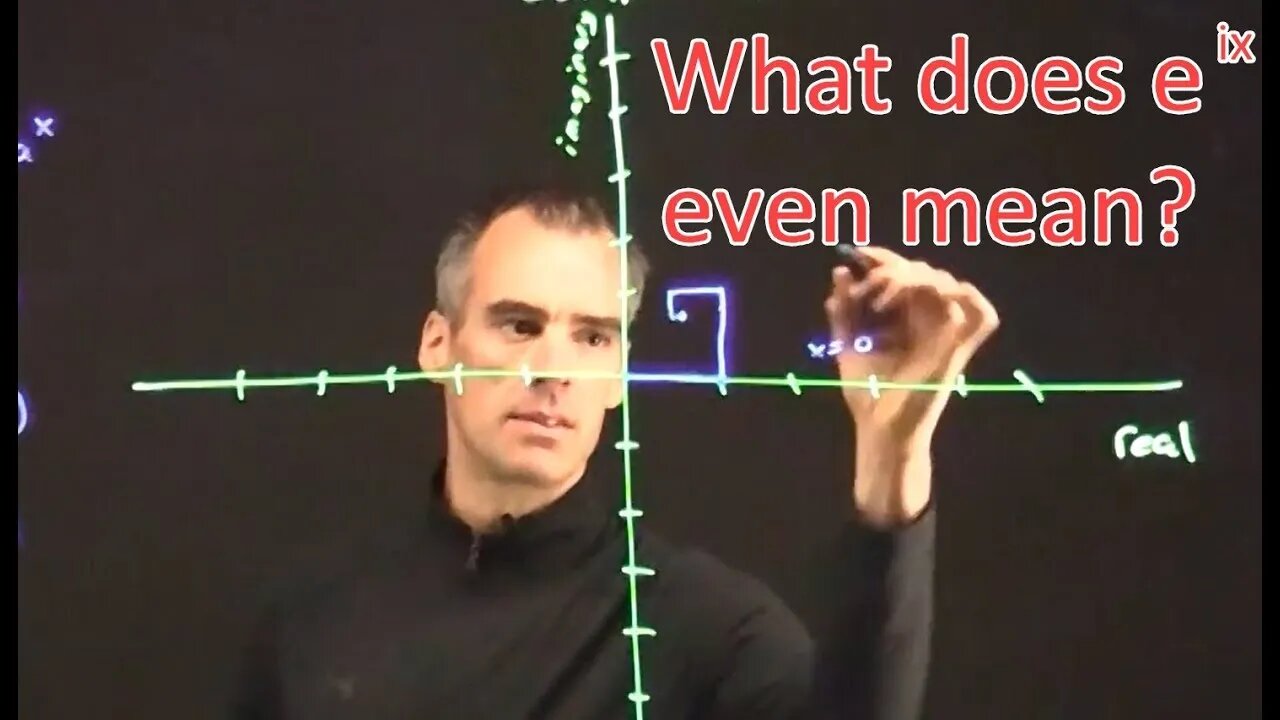Premium Only Content

What does e^ix even mean?
Video reviews where e comes from, how we deal with exponents, and ultimately explains how e^ix yields a unit circle in the complex plane.
Before we get into e^ix, let's first discuss e^x, which I trust you are familiar with it. By way of review though, say we are plotting out a function f(x)=a^x in red here. If a=2 we have this red line here, and the derivative of the function is g(x) = ln(2)*2^x or 0.69*2^x, which is going to be less than the initial function as shown by this plot.
But if a=4, then the derivative will be ln(4)*4^x, which would be higher than the original function, So e is of course that special number in the number that if fine-tuned to around 2.7, we get the derivative being the same as the original function.
So recall what the exponential function means. If I want to find e^3, that is just e*e*e, right? You could also consider this e^1 * e^1 *e^1, and then you add up all the 1's in the exponent to get e^3. But what if I want e^0.5? Well, based on the properties of exponents, we know that e^0.5 * e^ 0.5 would equal e^1 since the exponents add, so (e^0.5)^2 = e, so we know e^0.5 must be the square root of e.
What about e^2.5, well that would be e^1*e^1*e^0.5 = e*e*sqrt(e).
But how in the world could you find e^2i, for example. If the exponent is the number of times your are multiplying the number e, what does it even mean to multiple something by itself the square root of –1 times? It almost looks like nonsense right? But to see this we need to turn to a more rigourous way to calculate e^x, like how your calculator does it, through it's Taylor Series expansion, which perhaps you recall as
So for example if we want to find e^1, we plug in 1 for all those x values and we get...
e1= 1 +11+½ +13∗2+14∗3∗2+… = 1 +1 +½ +16+124+.. = 1 + 1 + 0.5 + 0.167 + 0.042
Which gives you 2.709, which is getting close to our initial e value, or e^1.
OK, so instead of x=1, lets simple plug in x = 1*I, or x=I.
Now we get e^1i = 1 +i + i^2/2! + i^3/3! + i^4/4! = 1 + i + (-1)/2! +(-i)/3! +1/4! = 1 + i –1/2 -i/6 +1/24 = 1+I-0.5-0.167i+0.042
So this is similar to the numbers we had earlier, except now we have some I's and some negatives sprinkled in here, so to see what this means, let's take a look at the complex number plane where the x axis is our real numbers and the y axis is our imaginary numbers.
So we start off by adding 1, then we go up i, then we go back –0.5, then we go down 0.167 in the negative I direction, then we finally go up 0.042, and after all that we are around 0.542+0.833i
So when we include the I in there, we are not simply adding more and more values like in the case above with e^1. Now each new value adds and subtracts on the real and imaginary lines so we are sort of spiraling around to our value. So this is why e^ix doesn't take off 'exponentially' and get really big like e^x, it's because these terms in the taylor series are cancelling each other out. In fact you, can notice that each time successive term is multiplied by another I, and that effectively causes our addition to rotate 90 degrees on the is complex plane each time, so we are adding smalling values in a spiral.
Crazy thing, well, lots of craziness with e^ix, but this spiral keeps going and ends up putting us on the unit circle here.
Since we're on the unit circle, where do you imagine the value of pi/2 might get us? If we plug x=pi/2 into our Taylor Series we get:
Which spirals around to 0.02+0.92i, which is pretty close to the point (0,1) on the unit circle, but not quite so ideally we would have added a few more values in the series.
Then if we plug in x=pi, we need to add several more terms to get this spiral under control, and adding up the first eleven terms we get: -1.002 + 0.007i
So you can see the addition and subtraction of the subsequent Taylor series values spirals us into the correct spot on the unit circle. So e^pi*I represents traveling from (1,0) to the point (-1, 0) along the unit circle over a distance of pi.
This connection with the unit circle is why we get Euler's formula
E^ix = cos(x)+isin(x)
Where the real values are reprsented by the cosine function and the imaginary values by the sin function.
Often times e^ix is much easier to use for calculations which makes this identity extremely helpful in electrical engineering. There is so much more to be unpacked with this formula, such as insights from the derivatives of the functions, but, while perhaps still baffling, I hope this gives you a little appreciation for how the exponential function can actually represent the unit circle and correspond to cosine and sine values when you throw an I inside the exponent. And if it does make sense a little, this will help you immensely towards understanding how and why we use this formula to model the physics behind so many aspects of electrical engineering, such as AC circuits or electromagnetic waves.
-
 26:00
26:00
DeVory Darkins
1 day ago $11.62 earnedDemocrat Mayor HUMILIATES himself during painful interview as Trump makes SHOCKING Announcement
35.4K93 -
 22:14
22:14
Ohio State Football and Recruiting at Buckeye Huddle
1 day agoOhio State Football: Everything Steve Sarkisian Said About the Buckeyes This Week
19K -
 1:19:55
1:19:55
TruthStream with Joe and Scott
1 day agoLisa, Michelle and Carole join Joe for Healing and Inspiration. Next healing will be on Aug 28th at Noon and 4pm eastern https://www.balancingbodyandsoul.com/?ref=TRUTHSTREAMSHOW
12.1K1 -
 10:32
10:32
Nikko Ortiz
17 hours agoFunniest Fails Of The Month
36.9K4 -
 28:59
28:59
The Jack Brewer Show
14 hours agoThe Jack Brewer Show S1 EP5 Charles Duke Tanner on Redemption, Fatherhood & Second Chances #podcast
6.37K -
 15:33
15:33
Bearing
1 day agoSEPTUM RING THEORY 💥 Are Nose Ring Girls ALL INSANE LIBERALS?! 💀🤣
12K57 -
 1:18
1:18
WildCreatures
2 days ago $1.22 earnedTourists unintentionally come face to face with jaguar in Brazil's Pantanal
8.24K15 -
 40:36
40:36
State of the Second Podcast
19 hours agoWhy Training Is an Investment in Your Life (ft. Tre’Von Barber)
10.2K -
 1:03:43
1:03:43
Dialogue works
1 day ago $3.11 earnedCol. Larry Wilkerson: Warning Signs Everywhere: U.S. on the Verge of Disaster
26.6K11 -
 1:09:42
1:09:42
Mike Rowe
7 days agoHow Did THIS Dirty Job Make Tommy Mello A Billionaire?! | #447 | The Way I Heard It
97.2K22